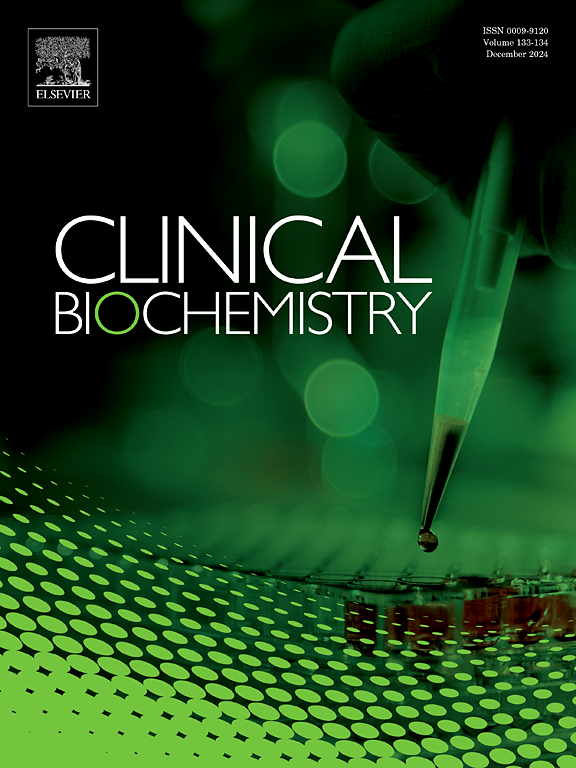Improving laboratory stewardship through benchmarking: A focus on thyroid function tests ordering
IF 2.1
3区 医学
Q2 MEDICAL LABORATORY TECHNOLOGY
引用次数: 0
Abstract
Objectives
Thyroid function tests, particularly thyroid-stimulating hormone (TSH) and free thyroxine (fT4), are among the most frequently ordered laboratory tests. This study evaluates longitudinal trends in thyroid testing utilization, assesses the impact of TSH-first reflex testing, and examines specialty-specific differences in test ordering patterns under the PLUGS (Patient-Centered Laboratory Utilization Guidance Services) benchmarking guidelines.
Methods
We analyzed TSH and fT4 test volumes from the year 2009 to 2023. A TSH reflex algorithm, which automatically orders fT4 following an abnormal TSH, was implemented in 2016. The metrics were evaluated using the TSH to fT4 ratio (TSH/fT4) and the percentage of fT4 tests associated with abnormal TSH. Specialty-specific differences were assessed by categorizing providers’ specialty, comparing benchmark patterns and diagnostic codes.
Results
Both TSH and fT4 testing volume increased significantly from 2009 to 2023. After the implementation of TSH-first reflex algorithm, TSH/fT4 stabilized (∼3.7) and the percentage of fT4 tests associated with abnormal TSH increased significantly from 26 % to 39 %. Providers from primary care demonstrated stronger adherence to the reflex testing, whereas endocrinology and oncology required more tailored approaches.
Conclusions
This first longitudinal analysis of thyroid testing under the PLUGS benchmark guidelines highlights improved efficiency following reflex test implementation, though specialty-specific differences persist. Consensus-based benchmarks and laboratory stewardship initiatives further enhance test utilization efficiency, optimize workflow, and ensure appropriate thyroid function testing across diverse clinical settings.
通过标杆管理改进实验室管理:重点关注甲状腺功能测试订购
目的甲状腺功能检查,尤其是促甲状腺激素(TSH)和游离甲状腺素(fT4),是最常用的实验室检查。本研究评估了甲状腺检测使用的纵向趋势,评估了TSH-first反射检测的影响,并在插头(以患者为中心的实验室利用指导服务)基准指南下检查了检测订购模式的特殊差异。方法分析2009 - 2023年的TSH和fT4检测量。TSH反射算法在2016年实现,该算法在TSH异常时自动订购fT4。使用TSH/fT4比率(TSH/fT4)和fT4测试与异常TSH相关的百分比来评估指标。通过对提供者的专业进行分类,比较基准模式和诊断代码来评估特定专业的差异。结果2009 - 2023年TSH和fT4检测量均显著增加。实施TSH-first反射算法后,TSH/fT4稳定(~ 3.7),fT4检测与异常TSH相关的百分比从26%显著增加到39%。初级保健提供者对反射测试的依从性更强,而内分泌学和肿瘤学则需要更量身定制的方法。这是第一次在plug基准指南下对甲状腺测试的纵向分析,强调了反射测试实施后效率的提高,尽管特殊特异性差异仍然存在。基于共识的基准和实验室管理举措进一步提高了测试利用效率,优化了工作流程,并确保在不同的临床环境中进行适当的甲状腺功能测试。
本文章由计算机程序翻译,如有差异,请以英文原文为准。
求助全文
约1分钟内获得全文
求助全文
来源期刊

Clinical biochemistry
医学-医学实验技术
CiteScore
5.10
自引率
0.00%
发文量
151
审稿时长
25 days
期刊介绍:
Clinical Biochemistry publishes articles relating to clinical chemistry, molecular biology and genetics, therapeutic drug monitoring and toxicology, laboratory immunology and laboratory medicine in general, with the focus on analytical and clinical investigation of laboratory tests in humans used for diagnosis, prognosis, treatment and therapy, and monitoring of disease.
 求助内容:
求助内容: 应助结果提醒方式:
应助结果提醒方式:


